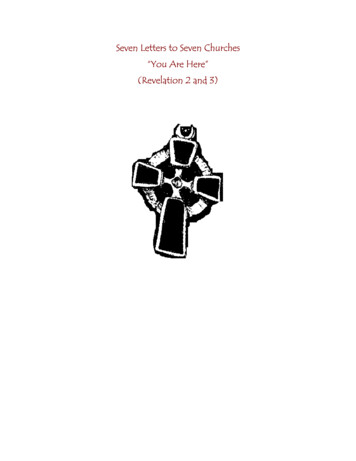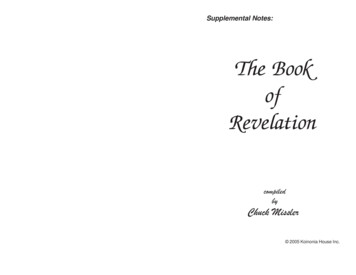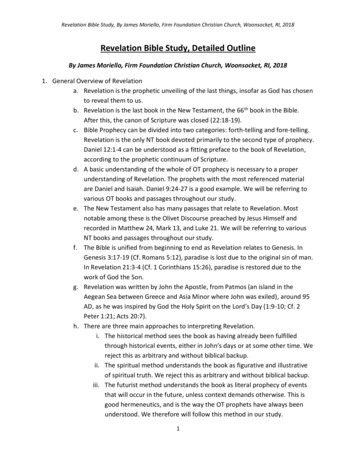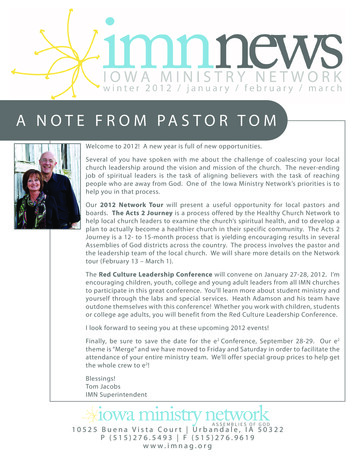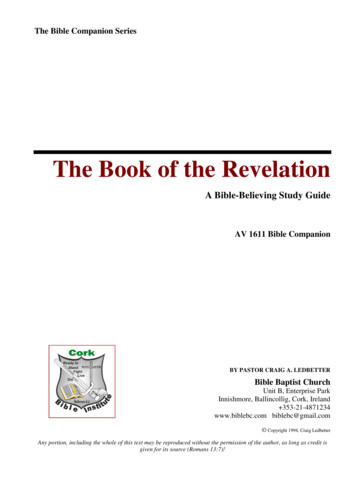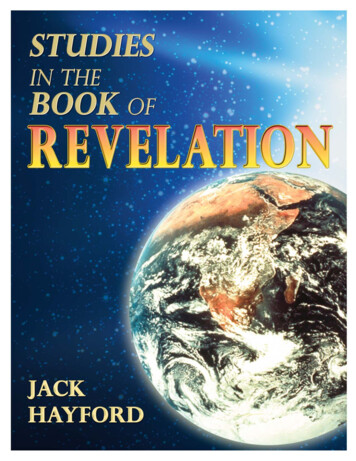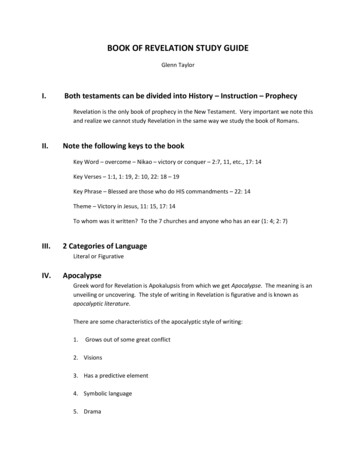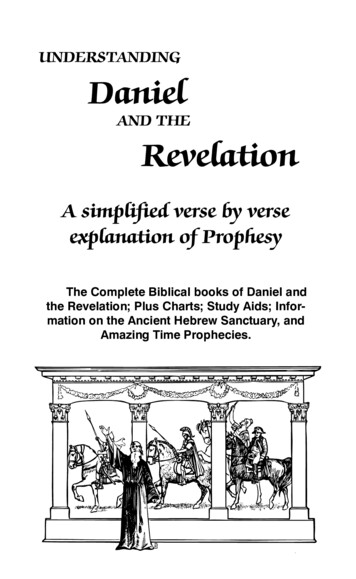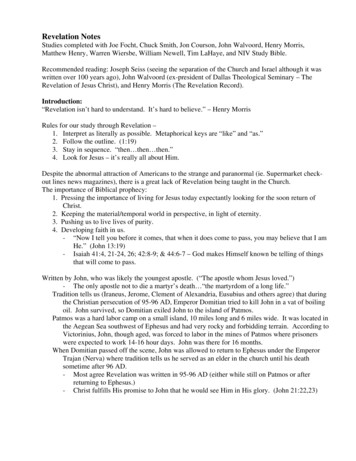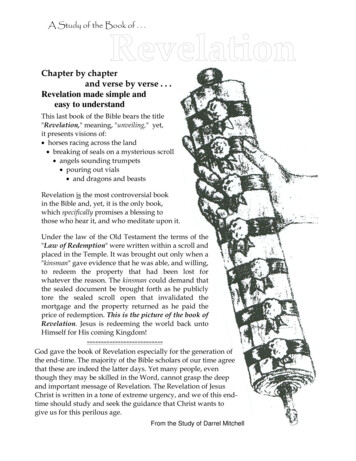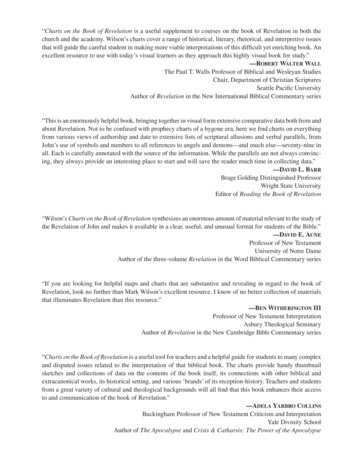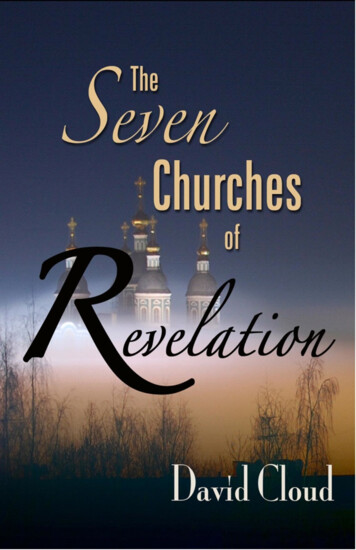
Transcription
e Seven Churches of Revelation en and NowCopyright 2010 by David W. Cloud is edition February 2012ISBN 978-1-58318-165-2 is book is published for free distribution in eBook format. Itis available in PDF, MOBI (for Kindle, etc.), and ePUB formatsfrom the Way of Life web site. We do not allow distribution ofthis book from other web sites.Published by Way of Life LiteraturePO Box 610368, Port Huron, MI 48061866-295-4143 (toll free) - ns@wayoflife.orgwww.wayoflife.orgCanada: Bethel Baptist Church4212 Campbell St. N., London Ont. N6P 1A6519-652-2619Printed in Canada byBethel Baptist Print Ministryii
Table of ContentsIntroduction .1Archaeology’s Discoveries .3Miscellaneous .9Viewed Prophetically .11 e Church at Ephesus .21 e Church at Smyrna .44 e Church at Pergamos .53 e Church at yatira .65 e Church at Sardis .82 e Church at Philadelphia.91 e Church at Laodicea .104Conclusion.121About Way of Life’s eBooks .122Powerful Publications for ese Times .123iii
“He that hath an ear, let him hear what theSpirit saith unto the churches.”iv
Introduction is is a study of Christ’s messages to the seven churches ofAsia in Revelation chapters two and three as well as aneyewitness survey of the locations of the churches as theyexist today from a tour we made in 2008.In the apostle John’s day the seven cities were located in aprovince of the Roman Empire called Asia, but today they arelocated in western Turkey. is part of the world is also calledAsia Minor. e seven cities are situated in a rough crescent about 400miles in length, beginning with Ephesus on the coast by theAegean Sea. About 60 miles north is Smyrna, and about 100miles further north is Pergamum. From Pergamum you gosoutheast about 100 miles to yatira, then another 50 milessoutheast to Sardis, then 40 miles southeast to Philadelphia,and finally 50 more miles southeast to Laodicea.When John wrote the book of Revelation under divineinspiration, he was imprisoned on the island of Patmos,which is about 50 miles off the coast of Turkey in the AegeanSea. us, he was not far from the churches to which he waswriting.Asia Minor was part of the Byzantine Empire, with itsheadquarters in Constantinople. e ruins of churches thatexist today are from that period and represent the GreekOrthodox faith. An example is St. John’s Basilica nearEphesus. We saw an interesting thing in the ruins theretestifying to the biblical truth of believer’s baptism. eancient baptistery is nearly waste deep, and the only purposefor such a baptistery is immersion. It is almost exactly thesame size and depth as the baptistery that we use in ourchurch planting ministry in South Asia.In the 15th century the Muslims conquered Constantinopleand renamed it Istanbul. It was the headquarters for theOttoman Empire until its dissolution in 1918. Today Turkey1
is a democracy but the vast majority of the people are Muslimand Christians are o en persecuted if they attempt toevangelize. e countryside is rolling hills and small mountains,watered by rivers and streams and by rains part of the year. Itis an agricultural paradise. Western Turkey is one of thebreadbaskets of Europe. ey export 80 types of fruits and 50types of vegetables and are a major producer of olives, grapes,cotton, wheat, rice, and tobacco. Olive oil and wine have beentwo of the region’s major products since ancient times.Turkey is the home of angora wool (the source of mohair),and sheep and goats are common sights in the region of theseven churches.Western Turkey is an interesting mixture of old and new. e large-scale farming is done with machinery, but there arestill many smaller farms that are operated by hand, usinghorses, donkeys, buggies, wagons, sickles, and other thingsthat would be recognized by the apostle Paul if he were towalk on the scene today.When the book of Revelation was written the province ofAsia was a peaceful, prosperous place, lying at the very heartof the Empire. New roads connected the cities. Bandits andpirates were under control. Public works were massive andfar-reaching. An efficient financial and banking systemexisted. Coins were in common use. Business opportunitieswere great. Many people traveled extensively for business andpleasure. Public entertainment was provided in the form ofplays, concerts, orations, sports, and gladiatorial fights.2
Archaeology’s DiscoveriesHigh quality photographs of the following things can befound in Christ’s Messages to the Seven Churches videopresentation series, which is available from Way of LifeLiterature, www.wayoflife.org. e archaeological excavations from the Roman period areextensive and far exceeded our expectations. earchaeological recoveries at Aphrodisias, Pergamum,Hierapolis, Laodicea, Sardis, and Ephesus are world class andcan compete with anything I have seen in Greece and Italy.And in Turkey you are allowed wonderful access to examinethe ruins up close.We got a great feel for what conditions were like during thedays of the Lord’s apostles when they traveled across theRoman Empire preaching the gospel and establishing the firstchurches. e aqueduct systems that brought water to the cities wereextensive and well designed, and sections of them still standin places. ere were three aqueducts that suppliedPergamos. One was 50 miles long. e gates to the cities were impressive. e cities weresurrounded by walls and there were gates at each entranceand sometimes there were inner gates as well.One of the gates to Ephesus is near the library. e Gate of Hercules in Ephesus was narrow to restrict theflow of people into the main part of the city.One of the main gates to Hieropolis was at the head ofFrontinus Street. ere were marble-paved avenues lined with marblecolumns and statues and shops. ese were sometimes lit atnight with lamps. Paul would have walked on these roads ashe entered these cities.3
e Arcadian Way in Ephesus ran from the harbor on theAegean Sea to the amphitheater.Today you can also see the remnants of the following:- e Priests’ Way in Ephesus- e Marble Way in Ephesus- e Sacred Way in Pergamos- e Frontinus Street in HieropolisTwo of the ancient streets of Laodicea have been recovered. ere were colonnaded porticos or porches leading tomajor buildings. ere were broad markets called agoras surrounded withporticos, columns, and statues. e one at Ephesus wassurrounded by a beautiful portico or covered porch on threesides and had three gates. Shops lined the portico. At thecenter of the Agora were a sundial and a water-clock. ere were elaborate monuments.Some parts of the cities were paved with tiles and mosaics,such as those we saw at Aphrodisias and Ephesus. e public baths were places for socializing and were richlyornamented. ey were built of concrete and overlaid withmarble veneer and decorated with carved figures, paintings,mosaics, and statues. e floors were tiled. Some had roomsas large as 200 yards square. ere were separate sections forcold water, warm water, and hot water. e water was heatedin furnaces and piped underground. ey had public toilets, such as those we saw in Ephesus,which could seat 50 people at once. ey were situated over acanal of running water that flowed into the city’s sewersystem. ere were beautiful fountains, such as the Fountain ofTrajan in Ephesus. And the Triton Fountain at Hierapolis. e Water Palace at Ephesus was probably the largestbuilding in the city. It acted as a reservoir to supply water tothe city through a network of pipes.4
ere were also magnificent libraries. e Celsian Libraryat Ephesus was a two-storey building with a beautifulcolonnaded façade. It was restored in the 1970s. A statue ofAthena sat in a prominent place inside. e gymnasiums were used for athletic training, education,and socializing. ey were o en connected to public bathsand small theaters and were ornamented with rare marble,statues, mosaics, and fountains. e one at Sardis had 100columns on the front façade. It was restored between 1965and 1973. e theaters and stadiums were very impressive. eyperformed plays, concerts, orations, festivals to the gods andgoddesses, gladiator competitions, and wild-animal fights.Condemned criminals would sometimes be burned alive orthrown to wild beasts. Christians, too, were tormented andkilled in public spectacles. e theater at Aphrodisias, completed in 27 B.C., was builtinto a hollowed out hill. It seated 7,000 and had a 3-storeymarble stage. e man who funded it was a freed slave of thefirst Roman emperor, Octavian Augustus. He was a native ofthe city who was probably captured by pirates and sold toOctavian. A er his release, he returned to Aphrodisias awealthy man. e theater at Hierapolis seated 20,000. e performancearea could be flooded with water for miniature mock navalbattles. e theater at Ephesus was built into the side of Mt. Pionand held 25,000 spectators. It had a 3-storey marble stage,which has not been restored. e stage acted as a soundingboard and actors speaking in a normal voice could be heardthroughout the theater.Pergamos had a large theater built on the side of theacropolis beneath the Temple of Trajan. It had 78 rows ofseats and a capacity of 10,000. e “acoustics were so perfectthat an actor speaking in a normal voice could be heard on5
the topmost seat” (J. T. Marlin, e Seven Churches of AsiaMinor). e stadium at Aphrodisias was about 300 yards long andhad 30 tiers of seating, with a capacity of 30,000. It is the bestpreserved and largest ancient stadium in the world. It was thescene of Greek athletic contests (foot races, long jumping,wrestling, discus, javelin throwing), gladiatorial contests, andwild-beast fights. It was built along the old city wall, parts ofwhich can still be seen. e gladiators o entimes fought to the death, a er givingthe traditional salute to the emperor: “Ave Caesar, morituri tesalutant!” (“Hail Caesar, we who are about to die saluteyou!”). e life of the loser could be saved if the governor andhis entourage gave a thumbs up sign. In the Ephesus museumthere is a chart that was recovered from tomb inscriptions,describing the careers of some of the gladiators. Age 21 - 4 years training, died during his 5th fight Age 23 - survived 8 fights, died during the 9th Age 27 - survived 15 fights, died during the 16th Age 30 - 34 fights 21 victories, 9 draws, 4 defeats(always pardoned) Age 48 - 19 victories, 20 years of service Age 60 - freed and pensioned e cities also had small theaters that were used as ameeting place for the city assemblymen as well as for plays,concerts, poetry readings, pantomimes, and speeches. eywere called Odeons. e one at Ephesus seated 2,000. eone at Aphrodisias seated 1,000. Originally it had a roof andwas entered by a lo y double-isled hall with marble columnsrunning down the center. It had an upper section which hasnot been restored.Wealthy people were buried in stone or marble casketscalled sarcophagi. ere is a large necropolis or burial groundoutside of Hierapolis with hundreds of these intact. e6
gardens and grounds were maintained by trade guilds. Manyof these have also been preserved in Ephesus. e cities of the Roman Empire were given over to idolatry. ey worshiped Zeus, Athena, Aphrodite, Artemis (Diana),Apollos, Eros, Nike, Poseidon, and countless other deities.Aphrodite, Artemis, and Diana were fertility goddesses(“the goddess of love”). Immoral rites were associated withtheir worship. ey were also mother goddesses. e ancient mothergoddess worship permeated the Roman Empire. Mothergoddess worship first appeared in ancient Babel and spreadthroughout the world. In the museum at Aphrodisias there isa section devoted to these goddesses. ere was Artemis,Cybele, Opy, Rhea, Vesta, Kubaba, Tanrika, and others. Someof the goddesses were depicted with a child. An example isTyche, the goddess of good luck. Another is Isis, who isdepicted holding the baby god Horus. is is where Romeborrowed its Madonna-Child veneration.Some of the old temples have been partially recovered. etemple of Aphrodite at Aphrodisias has some of the pillarsstill standing. e temple of Artemis at Sardis has beenpartially recovered. e temple of Artemis at Ephesus stoodat the head of the harbor and was one of the Seven Wondersof the World. It took 220 years to build and was 361 feet longand 180 feet wide. “It was built of cedar, cypress, whitemarble, and even gold, with which it glittered. . emagnificence of this sanctuary was a proverb throughout thecivilized world” (McClintock and Strong). e great altar of Zeus at Pergamos was 40 feet in heightand was world renowned. It featured intricate marblecarvings depicting a mythical battle between Greek gods(e.g., Zeus and Hercules) and giants. Significant parts of thealtar were recovered in the 1870s by German archaeologistsand it was reconstructed in the Berlin Museum.7
e Roman cities also worshiped the emperors. is wascalled the imperial cult. An annual festival was held andevery citizen was expected to participate. Refusal broughtpersecution upon the Christians.At Aphrodisias there was a temple called Sebasteion, whichwas dedicated to Julius Claudius. It was also associated withthe worship of Nike and Aphrodite. At Ephesus there was atemple of Hadrian. It was also associated with Fortune, thegod of fate. At Pergamum the temple of Trajan has beenpartially restored.We also saw the ruins of an ancient Jewish synagogue inSardis. Paul preached in the synagogues when he first came toa city. e one at Sardis is the largest ancient synagogue thathas been recovered. ere was a fountain in the entrance hall. e floors were covered with mosaics. e walls had designsmade of marble inlays. e main hall is thought to have had acapacity of 1,000. ere were thrones for Elijah and Moses. e throne of Moses was possibly occupied by the head rabbi,the president of the Sanhedrin, and the throne of Elijah byvisiting speakers. Smaller thrones have also been discoveredin the ruins of the synagogues at Chorazin in Israel, atHammath by Tiberius, and on the island of Delos in Greece.8
Miscellaneous1. Christ’s messages in Revelation 2-3 are addressed toseven individual churches in the Roman province of Asia inthat day. ere were many other churches in that province(e.g., the church at Colosse was located only a few miles fromLaodicea), but the Holy Spirit selected these seven inparticular. Seven is the number of completion, and Christselected these churches because they represented the variousconditions that He desired to address.2. e messages are not addressed to denominations orassociations or parachurch organizations. e application iseither to churches or to individuals.3. ere is a four-fold application of the messages:First, the messages were given to instruct the particularchurches to which they are addressed.Second, the messages were given to instruct all churches. einstruction given to the seven churches of Asia in the firstcentury applies to every church of every century (Rev. 2:7, 11,17, 29; 3:6, 13, 22). Each church that has ever existed issimilar to one of these seven. ird, the messages were given to instruct individualbelievers (Rev. 2:7, etc.). Every believer can find a wealth ofedification and spiritual challenge and warning in thesemessages.Finally, the messages offer a general overview of churchhistory. While this is not the main lesson of these chapters(and I believe that any approach that focuses exclusively oreven largely on this aspect is wrong), I do believe it is possibleto see a general outline of church history here by way ofapplication and I do not believe this is an accident. In fact,Revelation 3:10 obviously looks beyond anything that wasexperienced by the historical church at Philadelphia in thefirst century. By the divinely inspired order of the messages tothe seven churches we see the same pattern of increasing9
apostasy that is revealed in other ways in the New Testament.Compare 2 Timothy 3:1-5, 13; 4:3-4. 2 Timothy 3:13describes the course of the church age in terms of increasingapostasy: “But evil men and seducers shall wax worse andworse, deceiving, and being deceived.” I believe we are livingtoday both in the Philadelphian and the Laodicean age. eseages overlap. ough we are surrounded by the mostincredible apostasy, there are still many Bible-believingchurches that hold to the old paths and are patiently waitingto be saved out of the world before the tribulation begins. Aswith a parable, it is wrong to try to press every detailmentioned in these messages toward a historical overview,but the major features do lend themselves toward such anoverview in a surprisingly clear manner. eodore Epp said:“If I were to give a title to this section I would call it ‘ eGreat Apostasy of the Last Days Traced from the Beginningof the Church’s History.’ We will see how Satan uses what Icall ‘the whittling method’ of cutting away the essentialfeatures that make a church a church and finally makes it anarm of apostasy. Apostasy is defection from truth, revoltagainst it, and abandonment of what one has voluntarilyprofessed, or a total departure or desertion from one’s faith orrenunciation of it. is is a very serious matter; it began earlyin church history and will be consummated in the world a erthe true Church is gone. is decline in faith can be tracedthrough these seven churches with the climax in the greatapostate church of Revelation 17” (Epp, Revelation).10
Viewed PropheticallyEPHESUS (Rev. 2:1-7) -- e apostolic church leaving itsfirst love. e early churches as a whole gradually began toabandon their wholehearted zeal for Christ and His Word;they gradually ceased living by faith and settled downcomfortably in the world rather than walking as pilgrims in astrange land. “Ephesus means ‘desirable,’ such a term as aGreek applied to the maiden of his choice. Ephesus gives us apicture of the church as it was in the beginning, when theLord held the stars (His servants) in His hand and controlledtheir ministry. He sent them here and there, just as He would,to proclaim the glad gospel of His grace and to minister toHis saints. . e early church was walking in separationfrom the world. . In the days of Ephesus, believers could notbear those who were evil. . More than that, they were loyalto the truth” (Ironside).SMYRNA (Rev. 2:8-11) -- Persecution and poverty and thesynagogue of Satan. For more than 200 years the churcheswere persecuted by the Roman emperors. Christ mentions 10days of persecution, and there were 10 major periods ofpersecution under 10 principal pagan persecutors (Nero,Domitian, Trajan, Marcus Aurelius, Severus, Maximum,Decius, Valerian, Aurelian, and Diocletian). ere was alsomuch poverty, because during this period the believers o enhad to live hand to mouth and in hiding due to thepersecution. Judaism was also rampant throughout theRoman Empire and the Jews continued to hate the Christiansand to torment them as they did during Paul’s day. It iswritten in church history that the Jews provided the wood toburn Polycarp in Smyrna. “Smyrna means ‘myrrh.’ Myrrh hadto be crushed for it to emit its fragrance. is description setsforth the period when the church was crushed beneath theiron heel of pagan Rome, yet it never gave out such sweet11
fragrance to God as in those two centuries of almost constantmartyrdom” (Ironside).PERGAMOS (Rev. 2:12-17) -- Nicolaitanism was developedinto a doctrine and Balaamism was rampant. “Nicolaitan”means “to conquer the people” and refers to the rise of theunbiblical hierarchical doctrine of church government. Bythe days of Constantine in the fourth century the bishop ofRome was exalted, together with his cohorts, andNicolaitanism was well on its way to producing the papacy. Inthe early seventh century Gregory the Great solidified thepapacy, becoming “the first of the proper popes” (Schaff,History of the Christian Church, I. 15), and later that centuryPope eodore I was the first pope officially called sovereignor supreme Pontiff (General History of the Church, Darras, II,p. 232). At the same time, there was a gross breakdown ofseparation from the world (the doctrine of Balaam), andunregenerate pagans were brought into church membershipand their pagan practices, such as prayers to the dead andveneration of relics, were Christianized and adopted into thechurches. “Constantine’s patronage did what Diocletian’spersecution could not do: it corrupted the church, and sheforgot her calling as a chaste virgin espoused to an absentLord. en she gave her hand in marriage to the world thathad crucified Him, thus entering into an unholy alliance ofwhich she has never really repented” (Ironside).THYATIRA (Rev. 2:18-29) -- e Jezebel spirit; idolatry,fornication, and involvement in satanic things. Jezebel broughtfornication and idolatry into the churches and was associatedwith “the depths of Satan” (Rev. 2:20, 24). ese practices,which began in earlier periods, became settled doctrine asthe first millennium proceeded and the second began.Fornication became rampant in the Roman Catholic Churchbecause of its unscriptural doctrine of celibacy andconfession to a priest. e fornication surrounding thepapacy itself has been well documented. Idolatry became rifeand Mary was exalted as the chief idol. “Whoredom,12
witchcra , religious fasts,--and murdering God’s prophets,-this was Jezebel. Is not this also Rome? Jezebel also supporteda horde of idolatrous priests of her own--Babyloniansall” (Newell). “During this period also there began thatexaltation of Mary the mother of our Lord which has tendedto exalt her to the plane of a female deity through whomintercession to God should be made, and apart from whosefavor there can be no salvation. e prominence of a womanprophetess in the church at yatira anticipates thep r o m i n e n c e o f t h i s u n s c r i p t u r a l e x a l t at i o n o fMary” (Walvoord). “Jezebel was adept in the art of mixing.She undertook to unite the religion of Israel and the religionof Phoenicia. at is just what Romanism is--a mixture ofheathenism, Christianity, and Judaism. It is not Christianity-yet there is in it quite a bit that is Christian. From where didits superstition and image worship come? It was all takenfrom heathenism under the plea that it would help to convertthe pagans. e church became very accommodating. In thefourth, fi h, and sixth centuries, we find the churchcompromising with heathen rites and heathen ceremonies tosuch a degree that, by the seventh century, one could hardlytell heathen from Christian temples. e amalgamation issuch that it is almost impossible to separate the one from theother. . When He addresses Himself to the church of yatira, Christ speaks solemnly as ‘the Son of God.’ Whydoes the Lord Jesus Christ emphasize the fact of His deityhere? Because Rome everywhere has accustomed people tothink of Him as the Son of Mary” (Ironside).SARDIS (Rev. 3:1-6) -- A partial, insufficient reformation. is church had a name that it was alive, but it was actuallydead (Rev 3:1). Its works were not perfect before Christ (Rev.3:2). e church was told to remember the first works,referring to the New Testament pattern given by the apostles(Rev. 3:3). All of these things are characteristic of thedenominations that arose out of the Protestant Reformationin the 16th to the 18th centuries. ey le the Catholic13
Church and rejected some of Rome’s false beliefs andpractices, but they did not return to the pure apostolic model. ey held to infant baptism, a special priesthood, sacraments,liturgy, and other errors. ey established state churches andbrought the unsaved into church membership by the rite ofinfant baptism. us, though they had a name that they lived,they were largely dead. “Nothing could describe‘Protestantism’ more accurately! As over against Romishnight and ignorance, she has enlightenment and outwardactivity: the great ‘state churches,’ or ‘denominations,’ withcreeds and histories, costly churches and cathedrals,universities and seminaries, ‘boards,’ bureaus of publicationand propaganda, executors of organized activities, includinghome and foreign missions, even ‘lobby’ men to ‘influencelegislation’ at court! You and I dare compare the Church withno other model than the Holy Spirit gave at Pentecost and inPaul’s day! And compared to that--it has a name, but isdead” (Newell). “Nothing can be much sadder than vastcongregations of people who are baptized, banded together asChristians, ‘taking the sacrament’ of the Lord’s Supper,zealous for church and Christianity, and yet largely devoid ofpersonal, saving faith in Christ--trusting in forms,ceremonies, and what some people have called ‘birthrightmembership’ rather than in new birth through the Word andthe Spirit of God” (Ironside).PHILADELPHIA (Rev. 3:7-13) -- e churches that keepGod’s Word (Rev. 3:8) and escape the great tribulation (Rev.3:10). is depicts the remnant of sound churches thatremain true to God until the Rapture. From the fact thatJesus’ promise to the church at Philadelphia obviously looksbeyond anything that was experienced in that churchhistorically and can only apply directly to churches existing atthe time of the Rapture (“I also will keep thee from the hour oftemptation, which shall come upon all the world, to try themthat dwell upon the earth,” Rev. 3:10), we see that there will bePhiladelphia churches existing in the darkest hours at the end14
of the church age. Many people today have abandoned thechurch as an institution, but Jesus said, “I will build mychurch, and the gates of hell shall not prevail against it” (Mat.16:18), and He promised that He would be with it “even untothe end of the world” (Mat. 28:20). us in spite of thewidespread apostasy that exists in our day we can beencouraged that there are true Philadelphia churches in theworld and we are responsible to continue to support Christ’schosen institution until He comes. We agree with ArnoGaebelein when he said, “Philadelphia is not a definedchurch-period, but rather a description of a loyal remnantcalled out by the Spirit of God and bearing the finaltestimony to the whole counsel of God by word and deed.”And Harry Ironside makes the following observation:“Following the Reformation came a time when a cold, lifelessfor ma lism s e eme d to s ett le over all Protest antChristendom . But in the eighteenth and nineteenthcenturies a great wave of blessing came over all of those landswhere the Reformation had gone. God began to work afreshin mighty power. Marvelous awakenings occurred all overNorthern Europe and the British Isles. A half century later,the same mighty power began to manifest itself inAmerica. . A little later, in the early part of the last century,God began in a very special way to arouse many of Hispeople to a deeper sense of the value of His Word and its allsufficiency for the guidance of His people in thisscene” (Ironside).LAODICEA (Rev. 3:14-22) -- e unregenerate end-timechurch. is church is described as physically wealthy butspiritually wretched, and miserable, and poor, and blind, andnaked (Rev. 3:17). e Lord Jesus is standing outside of thischurch inviting individuals to come to Him. is is a pictureof the apostate churches of the last hours of the church age.Compare Revelation 18:4. “Laodicea is a compound wordmeaning ‘the rights of the people.’ Could any other term moreaptly set forth the condition of modern affairs? It is the era of15
democratization in both the world and the church. . espirit of this ultrademocratic age has invaded a large portionof the professed church. e authority of God and His Wordis rapidly being denied. e spirit of the age is the spirit of alarge part of the church; hence, the striking correspondenceb et we en t his letter to t he L ao dice ans and t helatitudinarianism so prevalent about us. . ere is neitherburning zeal for His Word nor yet absolute repudiation ofChrist and the Bible. Instead, there is a nauseating, lukewarmcondition that is abhorrent to the Spirit of God. . Never werechurch dignitaries and carnally minded religious leadersmore satisfied with themselves and their great work thantoday. ey advocate anything and everything that will seemto increase the church’s popularity. . Ah, beloved friends, it isgetting late in the dispensation, the night-shades are fastfalling, and the Lord who, in the beginning, was in the midstof His church, stands outside that lukewarm system that callsitself by His name, and He knocks in vain forentrance!” (Ironside). “It is Laodicean,--conformed ineverything to the popular judgment and will,--the extremeopposite of Nicolaitan. Instead of a Church of domineeringclericals, it is the Church of the domineering mob, in whichnothing may be safely preached except what the people arepleased to hear,--in which the teachings of the pulpit arefashioned to the tastes of the pew, and the feelings of theindividual override the enactments of legitimate authority. Itis lukewarm,--nothing decided,--partly hot and partly cold,-divided between Christ and the world,--not willing to give uppretension and claim to the heavenly, and yet clinging closeto the earthly,--having too much conscience to cast off thename of Christ, an
is book is published for free distribution in eBook format. It is available in PDF, MOBI (for Kindle, etc.), and ePUB formats from the Way of Life web site. We do not allow distribution of this book from other web sites. Published by Way of Life Literature PO Box 610368, Port Huron, MI 48061 86
